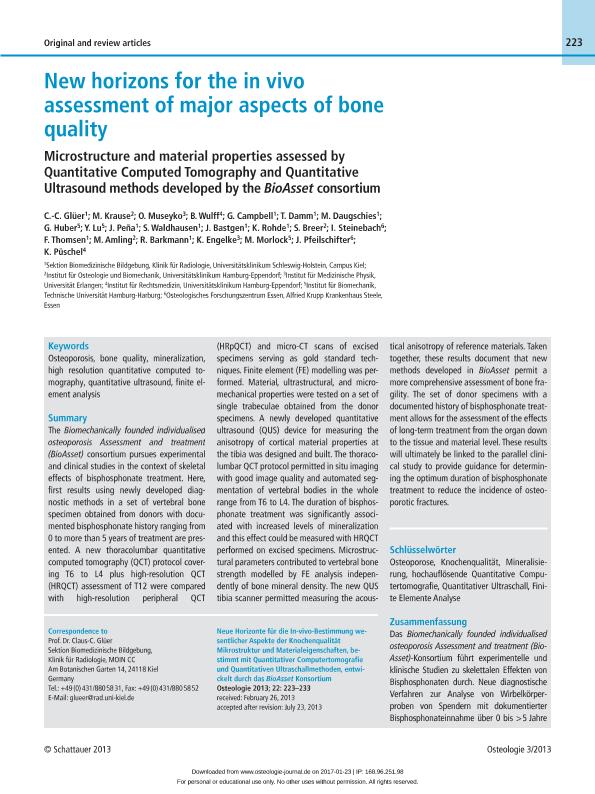Mostrar el registro sencillo del ítem
dc.contributor.author
Glüer, Claus C.
dc.contributor.author
Krausse, Matthias
dc.contributor.author
Museyko, Oleg
dc.contributor.author
Wulff, Birgit
dc.contributor.author
Campbell, Graeme
dc.contributor.author
Damm, Timo
dc.contributor.author
Daugschies, Melanie
dc.contributor.author
Huber, Gerd
dc.contributor.author
Lu, Yongtao
dc.contributor.author
Peña, Jaime
dc.contributor.author
Waldhausen, Sonja
dc.contributor.author
Bastgen, Jan
dc.contributor.author
Rodhe, Kerstin
dc.contributor.author
Steinebach, Inga
dc.contributor.author
Thomsen, Felix Sebastian Leo

dc.contributor.author
Amling, Michael
dc.contributor.author
Barkmann, Reinhard
dc.contributor.author
Engelke, Klaus
dc.contributor.author
Morlock, Michael M.
dc.contributor.author
Pfeilschifter, Johannes
dc.contributor.author
Püschel, Klaus
dc.date.available
2017-01-23T21:12:12Z
dc.date.issued
2013-07
dc.identifier.citation
Glüer, Claus C.; Krausse, Matthias; Museyko, Oleg; Wulff, Birgit; Campbell, Graeme; et al.; New horizons for the in vivo assessment of major aspects of bone quality: microstructure and material properties assessed by Quantitative Computed Tomography and Quantitative Ultrasound methods developed by the BioAsset consortium; Schattauer Gmbh-verlag Medizin Naturwissenschaften; Osteologie; 22; 3; 7-2013; 169-248
dc.identifier.issn
1019-1291
dc.identifier.uri
http://hdl.handle.net/11336/11748
dc.description.abstract
The Biomechanically founded individualised osteoporosis Assessment and treatment (BioAsset) consortium pursues experimental and clinical studies in the context of skeletal effects of bisphosphonate treatment. Here, first results using newly developed diagnostic methods in a set of vertebral bone specimen obtained from donors with documented bisphosphonate history ranging from 0 to more than 5 years of treatment are presented. A new thoracolumbar quantitative computed tomography (QCT) protocol covering T6 to L4 plus high-resolution QCT (HRQCT) assessment of T12 were compared with high-resolution peripheral QCT (HRpQCT) and micro-CT scans of excised specimens serving as gold standard techniques. Finite element (FE) modelling was performed. Material, ultrastructural, and micromechanical properties were tested on a set of single trabeculae obtained from the donor specimens. A newly developed quantitative ultrasound (QUS) device for measuring the anisotropy of cortical material properties was designed and built. The thoracolumbar QCT protocol permitted in situ imaging with good image quality and automated segmentation of vertebral bodies in the whole range from T6 to L4. The duration of bisphosphonate treatment was significantly associated with increased levels of mineralization and this effect could be measured with HRQCT performed on excised specimens. Microstructural parameters contributed to vertebral bone strength modelled by FE analysis independently of bone mineral density. The new QUS scanner permitted measuring the acoustical anisotropy of reference materials. Taken together, these results document that new methods developed in BioAsset permit a more comprehensive assessment of bone fragility. The set of donor specimens with a documented history of bisphosphonate treatment allows for the assessment of the effects of long-term treatment from the organ down to the tissue and material level. These results will ultimately be linked to the parallel clinical study to provide guidance for determining the optimum duration of bisphosphonate treatment to reduce the incidence of osteoporotic fractures.
dc.description.abstract
Das Biomechanically founded individualised osteoporosis Assessment and treatment (BioAsset) Konsortium führt experimentelle und klinische Studien zu skelettalen Effekten von Bisphosphonaten durch. Neue diagnostische Verfahren zur Analyse von Wirbelkörperproben von Spendern mit dokumentierter Bisphosphonateinnahme über 0 bis >5 Jahre wurden entwickelt. Mittels thorakolumbaler Quantitativer Computertomographie (QCT) und hochauflösender QCT (HRQCT) wurden Knochenmineraldichte (BMD), Mikrostrukturvariablen und Materialeigenschaften, insbesondere Mineralisierung, untersucht. Finite Element (FE) Modellierung dient der Bestimmung der Wirbelkörperbruchlast. Ein neues Quantitatives Ultraschall (QUS) Gerät zur Messung anisotroper kortikaler Materialeigenschaften wurde konstruiert. Ein signifikanter Zusammenhang von Mineralisierung und (Dauer der) Bisphosphonattherapie konnte mit Mikro-CT und HRQCT nachgewiesen werden. Das thorakolumbale QCT Protokoll ermöglichte eine Dosisreduktion von 60% gegenüber Standardprotokollen. Eine Finite Elemente Analyse zeigte BMD und Trabekelanzahl als unabhängige Determinanten der Bruchlast. Mit dem neuen QUS Gerät konnte die akustische Anisotropie von Referenzmaterialien bestimmt werden. Die Daten dokumentieren erweitere Diagnosemöglichkeiten zur Abschätzung von Knochenfragilität durch die neuen Verfahren. Parallel durchgeführte klinische Studien sollen die Frage der optimalen Dauer von Bisphosphonattherapie klären.
dc.format
application/pdf
dc.language.iso
eng
dc.publisher
Schattauer Gmbh-verlag Medizin Naturwissenschaften

dc.rights
info:eu-repo/semantics/openAccess
dc.rights.uri
https://creativecommons.org/licenses/by-nc-sa/2.5/ar/
dc.subject
Osteoporosis
dc.subject
Finite Element Analysis
dc.subject
Bone Quality
dc.subject
Quantitative Ultrasound
dc.subject
Mineralization
dc.subject
High Resolution Quantitative Computed Tomography
dc.subject.classification
Anatomía y Morfología

dc.subject.classification
Medicina Básica

dc.subject.classification
CIENCIAS MÉDICAS Y DE LA SALUD

dc.title
New horizons for the in vivo assessment of major aspects of bone quality: microstructure and material properties assessed by Quantitative Computed Tomography and Quantitative Ultrasound methods developed by the BioAsset consortium
dc.title
Neue Horizonte für die in vivo Bestimmung wesentlicher Aspekte der Knochenqualität: Mikrostruktur und Materialeigenschaften, bestimmt mit Quantitativer Computertomographie und Quantitativen Ultrasound Methoden, entwickelt durch das BioAsset Konsortium
dc.type
info:eu-repo/semantics/article
dc.type
info:ar-repo/semantics/artículo
dc.type
info:eu-repo/semantics/publishedVersion
dc.date.updated
2017-01-19T19:53:37Z
dc.journal.volume
22
dc.journal.number
3
dc.journal.pagination
169-248
dc.journal.pais
Alemania

dc.journal.ciudad
Stuttgart
dc.description.fil
Fil: Glüer, Claus C.. Universitätsklinikum Schleswig-Holstein; Alemania
dc.description.fil
Fil: Krausse, Matthias. Universitätsklinikum Hamburg-Eppendorf. Institut für Osteologie und Biomechanik; Alemania. Universitat Hamburg; Alemania
dc.description.fil
Fil: Museyko, Oleg. Universität Erlangen. Institut für Medizinische Physik; Alemania
dc.description.fil
Fil: Wulff, Birgit. Universitätsklinikum Hamburg-Eppendorf. Institut für Rechtsmedizin; Alemania
dc.description.fil
Fil: Campbell, Graeme. Universitätsklinikum Schleswig-Holstein; Alemania
dc.description.fil
Fil: Damm, Timo. Universitätsklinikum Schleswig-Holstein; Alemania
dc.description.fil
Fil: Daugschies, Melanie. Universitätsklinikum Schleswig-Holstein; Alemania
dc.description.fil
Fil: Huber, Gerd. Technische Universität Hamburg-Harburg. Institut für Biomechanik; Alemania
dc.description.fil
Fil: Lu, Yongtao. Technische Universität Hamburg-Harburg. Institut für Biomechanik; Alemania
dc.description.fil
Fil: Peña, Jaime. Universitätsklinikum Schleswig-Holstein; Alemania
dc.description.fil
Fil: Waldhausen, Sonja. Universitätsklinikum Schleswig-Holstein; Alemania
dc.description.fil
Fil: Bastgen, Jan. Universitätsklinikum Schleswig-Holstein; Alemania
dc.description.fil
Fil: Rodhe, Kerstin. Universitätsklinikum Schleswig-Holstein; Alemania
dc.description.fil
Fil: Steinebach, Inga. Alfried Krupp Krankenhaus Steele. Osteologisches Forschungszentrum Essen; Alemania
dc.description.fil
Fil: Thomsen, Felix Sebastian Leo. Universitätsklinikum Schleswig-Holstein; Alemania. Consejo Nacional de Investigaciones Científicas y Técnicas. Centro Científico Tecnológico Bahia Blanca; Argentina
dc.description.fil
Fil: Amling, Michael. Universitätsklinikum Hamburg-Eppendorf. Institut für Osteologie und Biomechanik; Alemania
dc.description.fil
Fil: Barkmann, Reinhard. Universitätsklinikum Schleswig-Holstein; Alemania
dc.description.fil
Fil: Engelke, Klaus. Universität Erlangen. Institut für Medizinische Physik; Alemania
dc.description.fil
Fil: Morlock, Michael M.. Technische Universität Hamburg-Harburg. Institut für Biomechanik; Alemania
dc.description.fil
Fil: Pfeilschifter, Johannes. Alfried Krupp Krankenhaus Steele. Osteologisches Forschungszentrum Essen; Alemania
dc.description.fil
Fil: Püschel, Klaus. Universitätsklinikum Hamburg-Eppendorf. Institut für Rechtsmedizin; Alemania
dc.journal.title
Osteologie

dc.relation.alternativeid
info:eu-repo/semantics/altIdentifier/url/http://www.schattauer.de/en/magazine/subject-areas/journals-a-z/osteology/contents/archive/issue/1788/manuscript/20255.html
Archivos asociados
